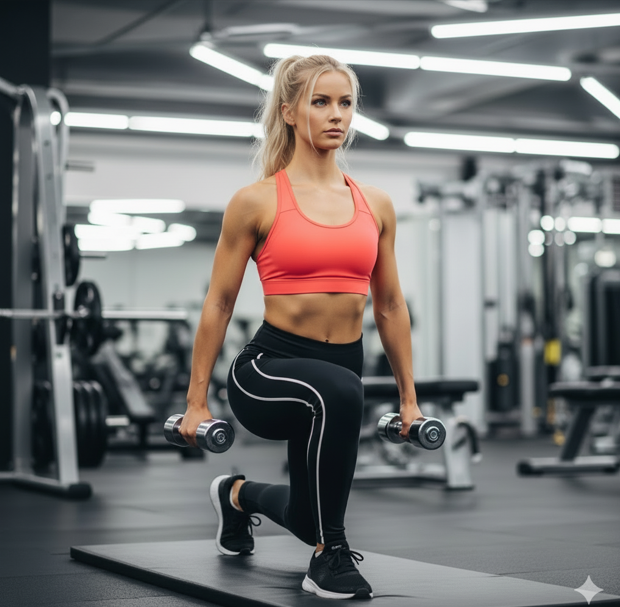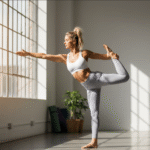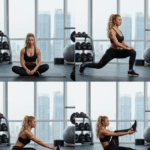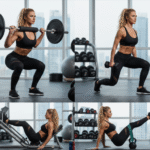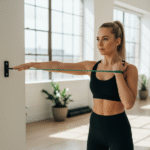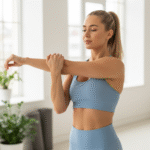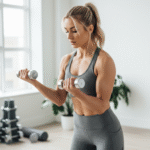Mastering the reverse lunge is a game-changer for building strong, stable, and powerful legs. This joint-friendly movement is a cornerstone of any effective lower-body reverse lunges workout. Here’s your ultimate guide to performing it perfectly, whether you’re using weights or just your bodyweight
Why the Reverse Lunge? The #1 Reason to Step Back ✨
If you’re wondering what are reverse lunges good for, the answer is simple: everything. By stepping backward instead of forward, you significantly reduce the stress on your knees, allowing you to focus on building strength and improving hip flexibility with better form and control.
How To Do Reverse Lunges?
- Find Your Stance: Stand tall with your feet hip-width apart. Engage your core, pull your shoulders back, and look straight ahead.
- Step Back: Take a controlled step backward with your right foot, landing on the ball of your foot. Your left foot should remain flat and stable.
- Lower Down: Bend both knees to lower your hips straight toward the ground. Aim to create two 90-degree angles. Your front thigh should be parallel to the floor, and your back knee should hover just above it.
- Drive Up: Push through the mid-foot and heel of your front (left) leg to powerfully return to the starting position. Squeeze your glute at the top.
- Repeat: Complete all reps on one side before switching, or alternate legs for a more dynamic flow.
Level Up: How to Add Weights to Your Reverse Lunge
Once bodyweight feels easy, adding weight is key for continued growth. Here are the most common ways:
- Dumbbells: Hold a dumbbell in each hand, letting your arms hang by your sides. This is the easiest way to start as it helps with balance.
- Kettlebells: Hold one kettlebell in the “goblet” position (at your chest), which also helps reinforce an upright torso.
- Barbell: Rest a barbell across your upper back (like a back squat). This is for advanced users due to the increased core stability required.
The movement pattern remains exactly the same. Focus on maintaining your upright posture and controlled descent, even under load.
Safety Tricks & Common Mistakes ⚠️
Safety Tricks:
- 🛑 Keep Your Torso Upright: Avoid leaning forward. Think “chest up, core tight” throughout the entire movement.
- 🛑 Watch That Front Knee: Ensure your front knee tracks in line with your toes and doesn’t cave inward.
- 🛑 Find Your Stride: A stride that’s too short will overwork your quad; one that’s too long can strain your hip flexor. Find the goldilocks zone for two 90-degree angles.
Common Mistakes:
- ❌ Rushing the Movement: Don’t bounce at the bottom. Control the descent and explode up with control.
- ❌ Letting the Back Knee Slam Down: Gently tap the floor if needed, but don’t put weight on that knee.
- ❌ Neglecting the Core: A loose core leads to a wobbly lunge. Brace your abs as if you’re about to be tapped in the stomach.
Want a Greater Challenge? Try Deficit Reverse Lunges 🔥
For advanced lifters seeking even more strength and flexibility, deficit reverse lunges are the answer.
- How: Stand on a small, stable platform (like a weight plate or a step). Perform the reverse lunge as usual, but now your back foot will step down onto the floor, creating a deeper range of motion.
- Why: This increases the stretch on the glutes and hamstrings of the front leg and demands greater stability and flexibility.
FAQ❓
Q: What are the main benefits of reverse lunges?
A: They build unilateral leg strength, improve balance and stability, enhance hip flexibility, and are significantly easier on the knees than forward lunges.
Q: How often should I do reverse lunges?
A: Incorporate them into your lower body or full-body workouts 1-2 times per week, aiming for 3 sets of 8-12 reps per leg.
Q: Are reverse lunges better for glutes or quads?
A: They target both! A longer stride emphasizes the glutes and hamstrings, while a shorter stride places more focus on the quadriceps.
Q: What’s the difference between a reverse lunge and a deficit reverse lunge?
A: A deficit reverse lunge is performed standing on a raised surface, which increases the range of motion and intensity for greater muscle growth and flexibility.
Q: Can I do reverse lunges if I have knee pain?
A: Always consult a doctor first. However, the reverse lunge is often recommended for those with knee issues as it places less stress on the knee joint compared to forward variations.
Pro Tip
🧠 Imagine you’re performing a squat with one leg. The power and drive should come almost entirely from your front leg.


